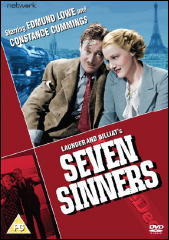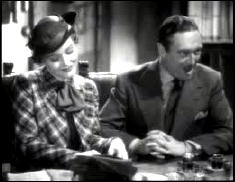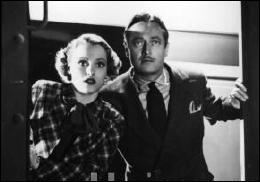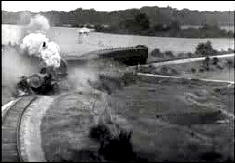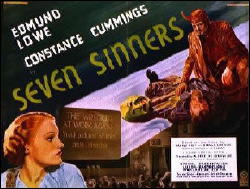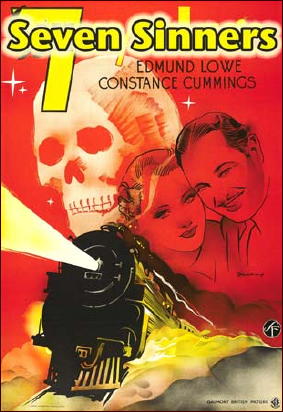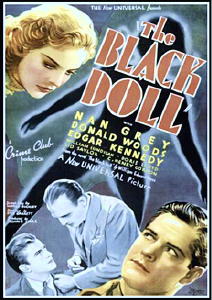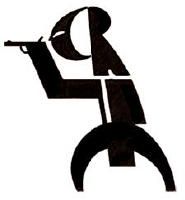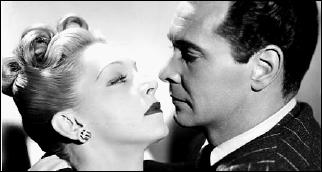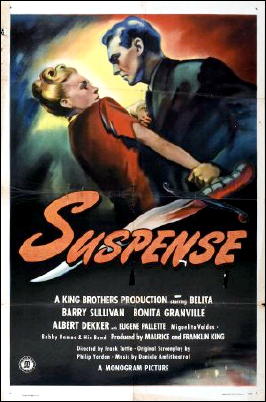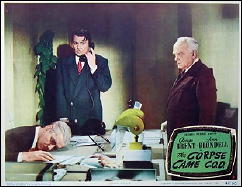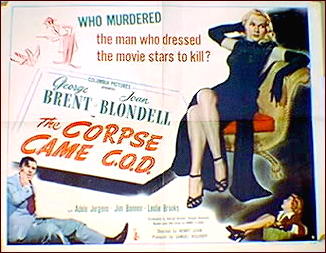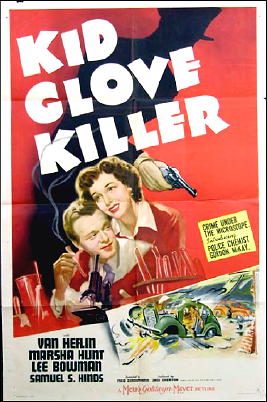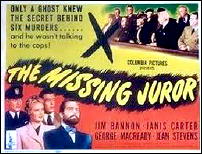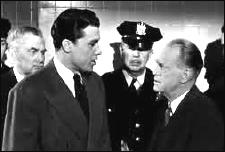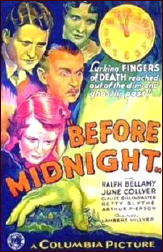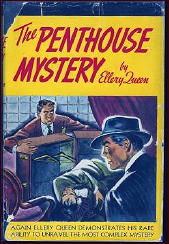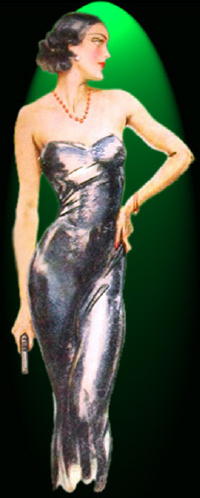Tue 28 Sep 2010
“Noir on a Boat” Films: A Checklist by David L. Vineyard.
Posted by Steve under Bibliographies, Lists & Checklists , Inquiries , Mystery movies[11] Comments
Steve and David —
Hi, it’s me again. I’m the one who suggested the recent “Man on the Run” lists which appeared on your blog, for which I am eternally grateful. They have been of enormous assistance.
Here’s another question, based on a thought that came to me, one somewhere between screwball and noir. It is about a retired single man who places a Personal ad in a sailing magazine (this is very common) seeking a woman to sail around the world with him “as long as it’s fun.” He finds the right woman and they set off, he falls in love and they get married. But of course she has another husband who wants her to kill the new husband to collect the insurance.
So it’s a noir on a boat.
Double Indemnity and The Postman Always Rings Twice certainly come to mind but I’m sure I’m missing some good ones. Murder on the High Seas (1932, aka Love Bound) is very dated. Body Heat meets Dead Calm meets A Fish Called Wanda is probably what I’m going for.
If there are any films you could recommend I would be even more eternally grateful. Thank you.
Josh
— —
Steve here first. I believe the most recent variation of the “Man on the Run” movie lists was actually a “Couples on the Run” list, which you can find here. (There are links in that post that you can use to find most if not all of the earlier ones.)
David Vineyard is much better at this than I am. Here’s his reply, which I received soon after I sent Josh’s new inquiry on to him:
DEAD CALM was the first to come to mind, but I can’t think of a lot of films with a similar premise. Most of the films with a sailing theme tend to be adventure films involving treasure or pearls, deep sea diving, and some tough skipper like John Payne (CROSSWINDS), Errol Flynn (MARA MARU), or John Wayne (WAKE OF THE RED WITCH).
John Sturges’s UNDERWATER with Jane Russell, Richard Egan, and Gilbert Roland is typical, but again it’s a treasure hunt movie, and existed mostly to exploit the then new technology allowing for extensive technicolor photography underwater.
There is a true story with a similar theme — minus the murder — Nicholas Roeg’s CASTAWAY from 1987 where Oliver Reed advertises for a woman to be marooned on a desert island with him and Amanda Donohoe answers the ad; based on Lucy Irvine’s book about her experiences. Oddly enough Irvine is every bit the knockout Donohoe is and the odder bits of the film are true.
As I said, there is no murder or crime — other than criminal stupidity on the part of Reed’s character — but you might pick up some ideas and Donohoe is nice to look at nude, semi nude, and in a bikini while the book is fully illustrated with color photos of Irvine in the same state.
You might also check out the miniseries AND THE SEA WILL TELL with Richard Crenna, based on Vincent Bugliosi’s book of the trial and investigation of a couple accused of murdering another couple on a yacht who were sharing a deserted island with them. Rachel Ward played Bugliosi’s client, on trial for murder. It used to show up regularly on cable and there may be a VHS or DVD.
Again, no murder, but THE LITTLE HUT with Ava Gardner, Stewart Granger, and David Niven has the wife, husband, and boyfriend all stranded on a desert island together after a shipwreck. Diverting little sex comedy handsomely shot in technicolor. At least you get to see what sort of a Tarzan Granger might have made.
Most of these are going to be set on islands rather than the boat.
A TOUCH OF LARCENY is a wry tale based on Andrew Garve’s THE MEGSTONE PLOT where Naval officer James Mason contrives to shipwreck himself on his holiday and be accused of treason while missing in hopes of making a fortune suing the British tabloids when he is rescued — everything goes wrong of course. You can check out my review here on the blog
A RAW WIND IN EDEN has wealthy Esther Williams plane crash and she is rescued on a remote island by Jeff Chandler where jealousy, murder, and every other complication ensues.
L’AVVENTURA by Michelangelo Antonioni is of course the classic film (skip the remake with Madonna) of a spoiled rich woman (Monica Vitti) ship wrecked with a crude sailor (Gabriele Ferzetti) .
At least a small section of ARRIVEDERCI BABY! features lonely hearts killer Tony Curtis and Black Widow Rossano Shiaffano trying to kill each other while sailing in a black comedy.
And you might check out CAPTAIN RON a particularly unfunny comedy in which Martin Short and family inherit a sail boat and take on captain Kurt Russell an eye patched drunken lecher for a vacation from Hell — if you are masochistic enough to sit through it.
Almost as bad is THE ISLAND based on Peter Benchley’s book about a modern man (Michael Caine) and his son whose yachting holiday is disturbed when they are taken hostage by latter day pirates. This is the one where Leonard Maltin’s terrible review noted “You know you are in trouble when David Warner is the most normal guy on the island.” He’s absolutely right, if anything he is too kind, though in fairness he has no lower rating than BOMB.
Again most are going to be the shipwreck theme more than the boat itself, everything from THE ADMIRABLE CRICHTON (Kenneth More, Diane Cliento) — which was also a Bing Crosby musical PARADISE LAGOON — to SWISS FAMILY ROBINSON.
You might check out EBB TIDE, a tough little adventure film based on Robert Louis Stevenson’s story with Ray Milland, Oscar Homloka, and Lloyd Nolan and remade as ADVENTURE ISLAND with Rory Calhoun. Nolan is quite good as the monomaniacal madman in the original, shot in early color.
There is a little British film from the post war period where a honeymooning couple sailing to Calais pick up a ship wreck survivor and find themselves involved in a smuggling plot, but the name escapes me — it’s a slight and very short comedy.
And there is another with John Cassavettes (of all people) where a honeymooning couple try living on a small island in the Caribbean, but again the name eludes me — should be easy enough to find though as Cassavettes didn’t do a lot of comedy. Laurel and Hardy’s last feature involved them on a small boat, shipwrecked, and with a nuclear bomb if my memory is right.
Ship board crime and murder is a little better represented, with THE PRINCESS COMES ACROSS (Carol Lombard and Fred MacMurray, reviewed here, DANGEROUS CROSSING (based on John Dickson Carr’s “Cabin B-13†with Jeanne Crain and Michael Rennie remade for television as TREACHEROUS CROSSING), THE GREAT LOVER ( Bob Hope and Rhonda Fleming), JUGGERNAUT (Richard Harris, Anthony Hopkins, Omar Sharif battle an extortionist), DARKER THAN AMBER (Rod Taylor as Travis McGee), and THE LAST OF SHEILA (James Mason, James Coburn, Anthony Perkins …).
That last one is an outstanding mystery/suspense film with an all star cast including Dyan Cannon, Joan Hackett, and Raquel Welch and written by mystery fans Perkins and composer Stephen Sondheim (who collaborated on Broadway with Hugh Wheeler, one half of Q. Patrick).
And of course disaster at sea is well represented in all three films entitled TITANIC (1943, 1953, 1997), A NIGHT TO REMEMBER, THE LAST VOYAGE, SHIP OF FOOLS, VOYAGE OF THE DAMNED (the last two more drama than disaster— save the emotional kind), ABANDON SHIP, ARISE MY LOVE, THE POSEIDON ADVENTURE, TWILIGHT OF THE GODS, GOLDEN RENDEZVOUS, CAPTAIN CHINA, KRAKATOA EAST OF JAVA (and it’s not East of Java, in fact it is West of Java), and Hitchcock’s LIFEBOAT.
Hammond Innes THE WRECK OF THE MARY DEARE was filmed by Michael Anderson with Charlton Heston and Gary Cooper and involved the skipper of small salvage ship uncovering skullduggery at sea. BREAK IN THE CIRCLE (based on the novel by Philip Loraine), THE HOUSE OF SEVEN HAWKS (based on Victor Canning’s HOUSE OF TURKISH FLIES), NEVER LET ME GO (based on Andrew Garve’s TWO IF BY SEA), ACTION OF THE TIGER (based on John Welland’s novel), and A TWIST OF SAND (based on Geoffrey Jenkins novel) all deal with international intrigue and small boats,
S.O.S. PACIFIC is a solid little suspense film about a plane load of Grand Hotel types who crash on an island that is about to be used for nuclear test — Eddie Constantine (for once in his own voice), Pier Angelli, Richard Attenborogh (outstanding), and John Gregson star and Guy Green directed. Really nerve wracking suspense — sort of a South Pacific version of Dick Powell’s SPLIT SECOND.
Hopefully this will be some help. Nothing really fits quiet as well as DEAD CALM, but some of these are in the same general area. There are a handful of horror and sf films that come close — everything from THE CREATURE OF THE BLACK LAGOON to some of the made for television Bermuda Triangle movies, but that list could go on forever, and I really don’t think you are interested in mutant sharks, zombies, aliens, and man eating fish.
But that’s all I can come up with off hand. Book wise you might try the novels of J.R.L. Anderson and Bernard Cornwell’s thrillers, they are to small boats what Dick Francis is to racing, and of course Charles Williams who wrote the novel DEAD CALM.
Dorothy Dunnett’s Johnson Johnson books usually involve sailing too, and so do many of the thrillers in the Buchan mold by Hammond Innes, Geoffrey Jenkins, Wilbur Smith, Desmond Bagley, Eric Ambler (as Eliot Reed with Charles Rodda), Andrew Garve, and such.
